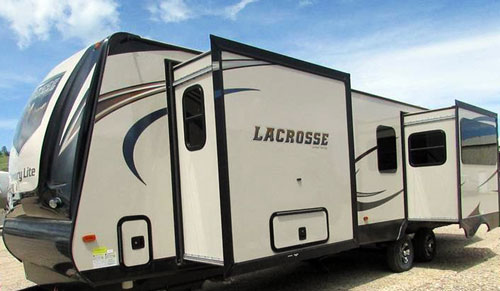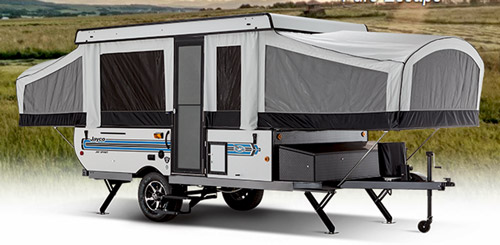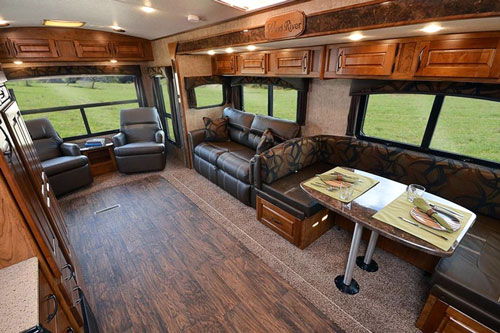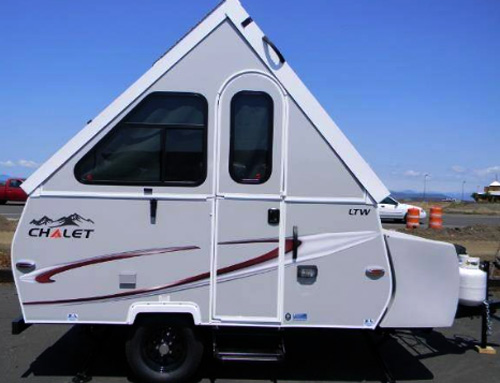Innovative RVs
Tradition vs New Concepts
New designs of folding, collapsible or expanding travel trailers present innovative ideas eliminating the problems of traditional tent pop-up campers....
Today many of us are living in the World of Excess (we not necessarily have chance to be part of it, but certainly all of us can see and/or feel it).
In the RV-ing world it means big, residential-like rigs with all kind of bells and whistles. And this RV lavishness leads to another one – a need for heavy-duty trucks (or motor-homes) being able to tow these “monsters”. Well, to be well understood – there is not much wrong with high-end RVs. The only problem is that if we want to make RV-ing affordable for majority of population then RVs themselves must be affordable, towable by cars we already own and easy to store for “out-of-season” in as little space as possible.

Prime Time RVs: LaCrosse model 337RKT is a real "King of the Road" and certainly with all its lavishness and beauty it does not loose its Royal Glory when on the campground! It's rather opposite as it really is an example of a "Home-away-from-home" However can you imagine what "car" you will need to safely tow it?
Well, the concept of folding/collapsible campers expresses the wish to meet two contradictory requirements. On one side there is a need to minimize the camper’s size for travel and storage while on the other side there is a growing “appetite” for more spacious and comfortable interior designed for family camping (typically 2+2). For long years, tent pop-up campers represented the most popular solution to these contradictory requirements. But recently this class of RVs seems to be losing its appeal and it is for good reasons:

Modern Jayco Sport tent pop-up camper has it all. It's beautiful, it nicely "blends" with the Mother Nature, yet by "definition" it simply cannot meet requirements listed below:
Vulnerability to weather
Rain is an obvious problem, but high and low ambient temperatures and difficulties with cooling/heating due to lack of insulation also make the list of weather-related “inconveniences”
Durability of canvas
They are prone to mold and “Wear & Tear” process – both undeniably shortening camper’s lifetime. While nothing lasts forever the fact is that these days the lifetime of modern all-fiberglass campers is almost unlimited (no rot, mold, leaks and structural deterioration…)
Complexity and time consuming of setting-up/folding down process
While in some circumstances setting-up the tent camper can be fun, in general, especially late evening or in bad weather conditions (rain, wind), it can be a nightmare. Not even mentioning that the process always takes time.
Maintenance
Think about folding down the tent pop-up camper in a rainy day! The next necessary step is to open it back on a warm, sunny day to dry wet canvas. And in-between, you may have to pray for sun to come sooner rather than later. Not mentioning difficulties to clean canvas from stains and grease (especially near the stove), or “accidentally” touching wet canvas from the inside when rains pours outside….
Summarizing: the tent-walled campers may still sound attractive for lovers of tent camping, for enthusiasts of “sleeping under the starry sky”. However for most of us, more and more “spoiled” and in need of comfort, pop-up tent campers are not the dream solution. The answer must come from the world of “hard-side” campers.

Wind River 280RLS: Large slide-out needs large empty space. Yes, it makes this RV roomy, spacious, a real "Home-away-from-home", but the price to pay for it is steep!
Slide-outs
The popular slide-outs definitely expand the living area, but they also need an empty space to slide-back. For this reason, they are mostly used in larger (and more expensive) RVs. The --> Gidget Brumby Teardrop Trailer is a surprising exception. And this is also the main reason why slide-outs are rarely (if at all) used in folding campers (Let’s not confuse slide-out modules with pull-out end beds typical in tent and hybrid campers).

Chalet LTW A-Frame camper is a great and very economic solution for two persons, but forget about the family of four (2 + 2 kids)...
A-Frame campers
A-Frame travel trailers were designed with the aim to eliminate most of the “troubles” related to tent pop-up campers. Indeed, they have low, aerodynamic profile in travel configuration, they are easy to store in the typical garage, they can be set-up/fold-down quickly and most importantly – thanks to hard walls they are weather “immune”. But they have one major limitation compared to tent travel trailers and it is the living space. Basically they are designed for only two people (eventually 2+1 child) – far from sleeping capacity of tent pop-up campers (typically 6, but is some cases even up to 10 people). Recent introduction of collapsible hard-wall “Attic” into the A-Frame design (example --> Aliner LXE) significantly improves the interior headroom but does not change the fundamental fact – the sleeping capacity.
No wonder that over the years we were seeing numerous attempts to find technically and commercially viable solution “reconciling” several contradictory requirements we expect from the “Dream Camper”. And these are:
- Low profile when on the road and storage
- Comfortable living space and conditions for the family of at least four when on the campground
- Some “out-of-grid” autonomy (these days roads “less travelled” are gaining popularity)
- Towability by popular SUVs, minivans (and possibly larger family cars). This also includes requirement for low weight (lite), aerodynamic profile and fuel efficiency
- Affordable cost.
So let's see the latest designs breaking with the traditional view of RVs. Some of them will conquer the market, some will never gain popularity, some are too new and "revolutionary" to jump to conclusions but certainly, all of them show human ingenuity and “out-of-the-box” thinking!
Go to: --> Innovative Recreational Vehicles
.